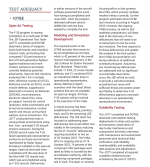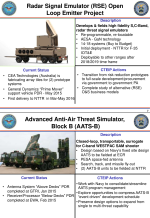Not only that. They can't even get a classified briefing, as they requested. The taste of sour grapes must taste nice. They keep coming back for more.
Is the Indian military interested in procuring the F-35A Lightning II from the US?
thediplomat.com
The Indian Air Force (IAF) is formally requesting a classified briefing by U.S. defense contractor Lockheed Martin on the capabilities of its fifth-generation stealth multirole F-35A Joint Strike Fighter Lightning II, the aircraft’s conventional takeoff and landing version,
according to Indian media reports.
The United States has not formally offered the aircraft to India and any classified briefing would require clearance by the U.S. Department of Defense and the U.S. Department of State. The
Business Standard reports that the IAF would possibly be interested in procuring up to 126 F-35As from the United States as a deal for 126 French-made Dassault Rafale multirole fighter aircraft fell through.
I love how the IAF after getting rejected they deny they ever asked for a briefing.
Btw don't mind my pet monkey who likes to post tranny pics to let me know what gets him off or the fact that he is still stuck on stupid when it comes to comprehending what General Hostage meant when he said F-35 is E-virus capable. Numb nuts wants details but he's too stupid to understand it's classified just like its APG-81 capability.
This article is what has him stuck on stupid.
-LANGLEY AFB: If you want to stop a conversation about the F-35 with a military officer or industry expert, then just start talking about its
cyber or
electronic warfare capabilities.
These are the capabilities that most excite the experts I’ve spoken with because they distinguish the F-35 from previous fighters, giving it what may be unprecedented abilities to confuse the enemy, attack him in new ways through electronics (think Stuxnet), and generally add enormous breadth to what we might call the plane’s conventional strike capabilities.
So I asked Air Force Gen. Mike Hostage, head of Air Combat Command here, about the F-35’s cyber capabilities, mentioning comments by former Air Force Chief of Staff Gen. Norton Schwartz several years ago about the F-35
having the “nascent capability” to attack Integrated Air Defense Systems (known to you and me as surface to air missiles) with cyber weapons.
Hostage deftly shifts the conversation each time I press for insights on the F-35’s cyber and EW. He doesn’t refuse to talk, as that would be impolite and, well, too obvious.
He starts off with what sounds like a shaggy dog story.
“When I was a youngster flying F-16s we would go fly close air support at the National Training Center for the Army,” he tells me. “They would have a large ground force: blue guys, OpFor [opposing forces], they’d go out and have big battles on the ground. And they would bring the [Close Air Support] CAS in to participate. They’d let us come in, we’d fly for 30 minutes and then they’d shoo us away because they wanted to have their force on force and if they allowed the CAS to participate during force on force it fundamentally changed the nature of the ground battle.”
Then he brings us back to the issue at hand, and mentions the Air Force’s Red Flag exercises, the pinnacle of the service’s force-on-force training: “Fast forward to today. We do Red Flag for the purpose of giving our young wingman those first 10 days of combat, or first 10 combat missions in a controlled environment because what we’ve studied over the years of conflict is the first 10 missions are where you’re most likely to lose your fleet. So if you can replicate that first 10 in a controlled environment with a very high degree of fidelity, you’ve greatly increased the probability that they’re going to survive their actual first 10 combat missions. So Red Flag is the closest we can get to real combat without actually shooting people.”
Allies are a key part of the Red Flag exercises, especially as the F-35 becomes the plane flown by most of our closest allies, from Britain to Israel to Australia and beyond. But the toughest, most realistic exercises at Red Flag occur when it’s only American pilots flying against each other.
During those Red Flag-3 exercises they integrate space and cyber weapons into the fight, including those the F-35 possesses. Those capabilities make are “so effective that we have to be very careful that in a real world scenario we don’t hurt ourselves allowing them to play.”
Then he gets back to the point at hand. “So, to answer your question, it has tremendous capability. We’re in the early stages of exploring how to get the most effectiveness out of cyber and space, but we’re integrating it into the Air Operations Center; we’re integrating it into the combat plan; and it is absolutely the way of the future. And you’re right,
the AESA radar has tremendous capacity to play in that game.”
Boil all that down and it comes to this. Gen. Hostage is saying that the F-35’s cyber capabilities are so effective — combined with space assets, which are often difficult to distinguish in effect from cyber capabilities — that the planes have to stop using them so the pilots can shoot at each other.
The obvious question that arises from this is, how can a radar system also be a cyber weapon? We’ve all seen those World War II movies where the radar dish sweeps back and forth. The energy beams out, strikes the enemy plane and comes back as a blip. What makes an AESA radar special is the fact that it beams energy in digital zeroes and ones — and the beam can be focused. This allows the radar to function as both a scanning radar, a cyber weapon and an electronic warfare tool.
AESA Radar, Cyber And IADS
Here’s an excellent explanation for how we go from radio and radar and military systems that are not connected to the Internet yet remain vulnerable to hacking that
I’ve cribbed from my deputy, Sydney Freedberg, from a recent piece he wrote in Breaking Defense about cyberwar. An enemy’s radios and radars are run by computers, so you can transmit signals to hack them. If the enemy’s computers are linked together then your virus can spread throughout that network. The enemy does not have to be connected to the Internet. You just need the enemy’s radios and radar to receive incoming signals – which they have to do in order to function.
So, as a former top intelligence official explained to me about two years ago, the AESA radar’s beams can throw out those zeros and ones to ANY sort of receiver. And an enemy’s radar is a receiver. His radios are receivers. Some of his electronic warfare sensors are also receivers.
But neither Hostage nor many others I spoke with were willing to be specific on the record about how effective the AESA radar, working with the aircraft’s sensors like the Distributed Aperture System and its data fusion system, will be. So the following is information culled from conversations over the last three months with a wide range of knowledgeable people inside government and the defense industry, as well as retired military and intelligence officers.
As the F-35 flies toward the Chinese coast and several hundred incoming PLAAF J-20s streak toward them in the scenario outlined in the first piece of this series, spoofing (using the enemy’s own systems to deceive him) will be a major part of our attack.
Enemy radar may well show thousands of F-35s and other aircraft heading their way, with stealth cross-sections that appear to match what the Chinese believe is the F-35’s cross section. Only a few hundred of them are real, but the Chinese can’t be certain which are which, forcing them to waste long-range missiles and forcing them to get closer to the US and allied F-35s so they can tell with greater fidelity which ones are real. The Chinese will try and use Infrared Search and Track (IRST) sensors, which have shorter ranges but provide tremendous fidelity in the right weather conditions. But that, of course, renders them more vulnerable to one sensor on the F-35 that even the plane’s critics rarely criticize, the Distributed Aperture System (DAS).-
What's so hard to comprehend, right?
I'm split whether I want India to have F-35's. Part of me says yes so that the handful of fools in here get severely butt hurt and don't have a choice but to stfu and the other part is somewhat evil... I want the PLAAF to continue to have an overwhelming edge over the IAF so that when a conflict does happens, which it will the way the world is going, they take a huge beating so that the many fools in here finally figure it out that their Rafale was nothing but a 4th gen fighter and nothing special.














